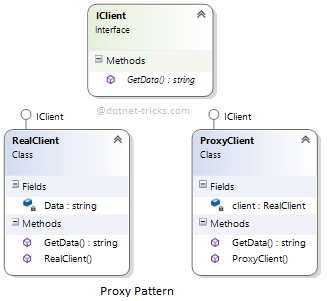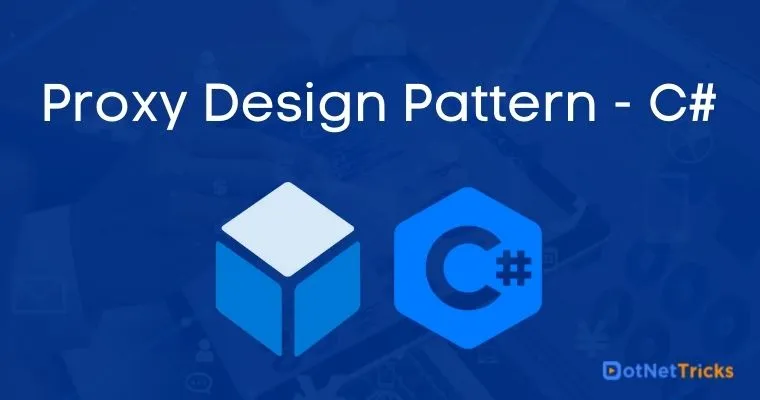Proxy Design Pattern

⭐ .NET Design Patterns Course: Design Patterns in C# Online Training
Proxy Design pattern falls under Structural Pattern of Gang of Four (GOF) Design Patterns in .Net. The proxy design pattern is used to provide a surrogate object, which references to other objects. In this article, I would like to share what is a proxy pattern and how is it work?
What is Proxy Pattern
The proxy design pattern is used to provide a surrogate object, which references to other objects.
The proxy pattern involves a class, called proxy class, which represents the functionality of another class.
Proxy Pattern - UML Diagram & Implementation
The UML class diagram for the implementation of the proxy design pattern is given below:

The classes, interfaces, and objects in the above UML class diagram are as follows:
Subject
This is an interface having members that will be implemented by RealSubject and Proxy class.
RealSubject
This is a class which we want to use more efficiently by using proxy class.
Proxy
This is a class which holds the instance of RealSubject class and can access RealSubject class members as required.
C# - Implementation Code
public interface Subject
{
void PerformAction();
}
public class RealSubject : Subject
{
public void PerformAction()
{
Console.WriteLine("RealSubject action performed.");
}
}
public class Proxy : Subject
{
private RealSubject _realSubject;
public void PerformAction()
{
if (_realSubject == null)
_realSubject = new RealSubject();
_realSubject.PerformAction();
}
}
Proxy Pattern - Example

Who is what?
The classes, interfaces, and objects in the above class diagram can be identified as follows:
IClient- Subject Interface.
RealClient - RealSubject Class.
ProxyClient - Proxy Class.
C# - Sample Code
/// <summary>
/// The 'Subject interface
/// </summary>
public interface IClient
{
string GetData();
}
/// <summary>
/// The 'RealSubject' class
/// </summary>
public class RealClient : IClient
{
string Data;
public RealClient()
{
Console.WriteLine("Real Client: Initialized");
Data = "Dot Net Tricks";
}
public string GetData()
{
return Data;
}
}
/// <summary>
/// The 'Proxy Object' class
/// </summary>
public class ProxyClient : IClient
{
RealClient client = new RealClient();
public ProxyClient()
{
Console.WriteLine("ProxyClient: Initialized");
}
public string GetData()
{
return client.GetData();
}
}
/// <summary>
/// Proxy Pattern Demo
/// </summary>
class Program
{
static void Main(string[] args)
{
ProxyClient proxy = new ProxyClient();
Console.WriteLine("Data from Proxy Client = {0}", proxy.GetData());
Console.ReadKey();
}
}
Proxy Pattern Demo - Output

There are various kinds of proxies, some of them are as follows:
Virtual proxies: Hand over the creation of an object to another object
Authentication proxies: Checks the access permissions for a request
Remote proxies: Encodes requests and send them across a network
Smart proxies: Change requests before sending them across a network
When to use it?
Objects need to be created on demand means when their operations are requested.
Access control for the original object is required.
Allow accessing a remote object by using a local object(it will refer to a remote object).
What do you think?
I hope you will enjoy the Proxy Pattern while designing your software. I would like to have feedback from my blog readers. Your valuable feedback, question, or comments about this article are always welcome.






